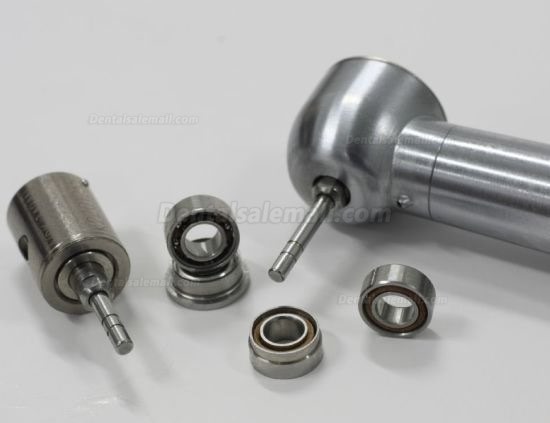Why do bearing assemblies on dental handpieces need special attention?
The bearing assembly, or “bearing” as referred to in the handpiece world, consists of several components (including the balls you expect). At the heart of the assembly are the actual ball bearings. These are generally stainless steel, although ceramic bearings are being widely used as well. The bearings ride around an inner ring called the inner race. There is a slight groove (raceway) on the outside of this ring that the ball bearings roll in. The inner race is generally the strongest part of the bearing assembly as it is what is pressed onto the spindle.
There is then a cage that holds the balls at equidistant intervals around the inner race. This keeps the turbine balanced. Think of an old washing machine with the clothes all on one side. The “clunk clunk” of the washer is caused by the erratic rotation due to improper weight distribution. The cage keeps the turbine spinning smoothly as it maintains an evenly distributed load (more on load later).

Bearing cages can be made of a variety of materials, generally, they are a polymer (i.e. plastic) and are usually the most fragile component of the entire dental turbine unit. The plastics used are very resistant to heat and have very low-friction as they directly contact the actual bearings.
Outside of the cage is the outer race. Just as with the inner race, there is a groove in which the bearings ride. The outer race rests on o’rings which in turn rest against the inside of the handpiece head.
The entire bearing assembly is then closed off with a shield. The shield is designed to keep debris from entering the cage and getting onto the bearings. Naturally, if debris gets onto the bearings it can throw the entire turbine out of balance, putting stress on the cage which then fails allowing the bearings to “clump” and causing the turbine to spin erratically (and eventually stop spinning completely).
All of these components are extremely small and thin. Whenever replacing a turbine, make certain you have removed all of these components of you old turbine from the handpiece. It’s very common for an o’ring, outer race, or shield to adhere to the inside of the handpiece(coxo dental handpiece) head (or end cap). Note also, that all of these components are simply pressed together using a bearing press and held together with friction. This is why a press is required if you wish to repair your own handpieces, saving you money.
Previous:What are the advantages of dental ultrasonic scaler?
